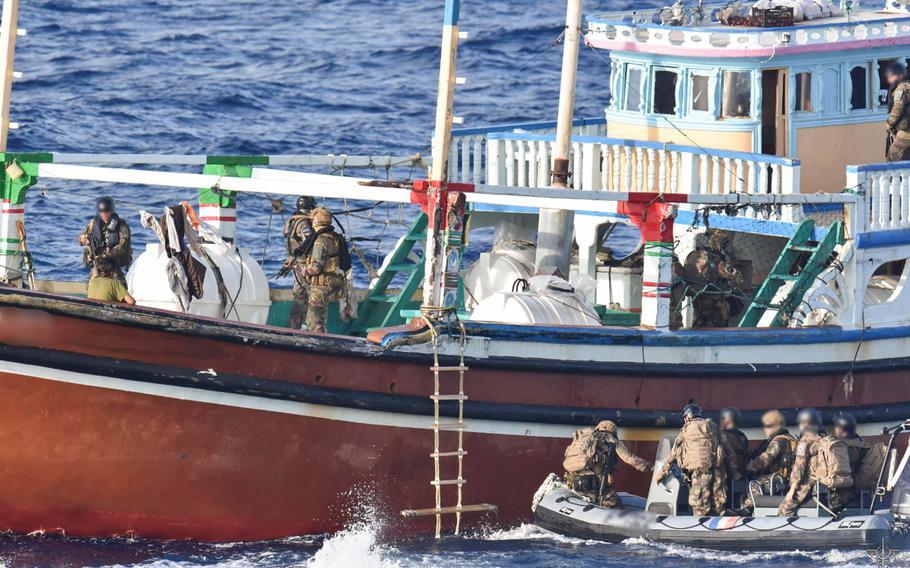
A French navy ship working with Combined Maritime Forces seized about 1,600 pounds of methamphetamine from a stateless vessel while operating in the international waters of the Indian Ocean, Nov. 4, 2023. (U.S. Naval Forces Central Command / U.S. 5th Fleet)
MANAMA, Bahrain — A recently seized ship carrying almost a ton of methamphetamine in the Indian Ocean represents a shift in illicit drug smuggling on the high seas, U.S. and French naval officials said.
“We used to find mostly hashish, (but) more and more we are finding synthetic methamphetamine,” French navy Capt. Yannick Bossu said in an interview last week at the U.S naval base in Bahrain.
French sailors, as part of a U.S.-led maritime alliance, seized almost 1,600 pounds of methamphetamine from a stateless vessel on its way to Africa in an operation in the Indian Ocean on Nov. 4.
“Those drugs are disseminated everywhere in the world from those hubs, to Europe, to the U.S., to Russia,” Bossu said. “What we are doing here contributes to the regional stability, but also to the security of our own populations all over the world.”
Smugglers at sea often use a well-known route to bring heroin and hashish from Pakistan to Kenya. But now smugglers are moving further south, with Mozambique being the destination of methamphetamine from “somewhere north of the Indian Ocean,” Bossu said.
The meth traveling on the high seas comes from Afghanistan, Pakistan and Iran, said Ali Latif, Asia editor at the New Humanitarian, a publication funded by the United Nations.
Methamphetamine production in Afghanistan skyrocketed over the last 10 years as families realized the drug was easy to produce, with the help of smugglers able to move the goods around the world.
Methamphetamine from Afghanistan has been seized as far away as France, Mozambique and Hong Kong, a brief by the United Nations Office on Drugs and Crime said in August.
“They’re getting it across a lot of borders and they’re all taking a cut,” said Latif, who has reported on the Afghan meth trade.
While most meth is exported by land, a significant amount is smuggled via ships, Latif said.
The illicit cargo seized by French sailors earlier this month was discovered as part of a flag verification boarding, Bossu said.
International law generally allows maritime law enforcement authorities to board stateless vessels. While sailors or other authorities are there, they can conduct a search.
Bossu’s task force, which patrols the Gulf of Oman, Arabian Sea and Indian Ocean, has seized almost four tons of methamphetamine, heroin and hashish in recent months, a U.S. 5th Fleet statement said last week.
Bossu’s task force operates as part of Combined Maritime Forces, a coalition led by a U.S. Navy vice admiral. The coalition counters piracy, trains allies and patrols Middle East waterways.
Seizures have slowed in recent months due to weather and “events in Israel and Gaza,” U.S. Navy Capt. Hamish Kirkland, chief of staff for Combined Maritime Forces, said last week.
U.S. naval assets were redirected from maritime patrols and redeployed after the Oct. 7 attack by Hamas in Israel, he said.
Combined Maritime Forces has been relying more on ships from other countries, such as the U.K. and France. U.S. naval vessels will return to the patrols soon, Kirkland said.
A statement by the 5th Fleet said that some $1.3 billion in illicit narcotics have been seized since 2021, though Kirkland noted that Combined Maritime Forces does not assign monetary values to seizures.
Cmdr. Rick Chernitzer, U.S. 5th Fleet spokesman, said public affairs staff use a formula based on the type and quality of the drug to roughly estimate seizure values.